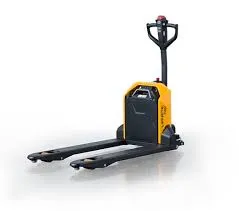The pivotal role of efficiency and safety in modern warehousing and logistical operations cannot be overstated. Among the slew of equipment integral to achieving this dual goal is the pallet truck with brakes—a tool whose utility and functionality set it apart in the realm of material handling. This article delves into the essential features, advantages, and considerations related to the use of pallet trucks equipped with braking systems, a topic of expertise for warehouse managers and logistics professionals seeking to optimize their operations.

In the busy environment of a warehouse, the seamless movement of goods is crucial. Pallet trucks, often the unsung heroes of these operations, have evolved with technological integrations to enhance their effectiveness. The integration of braking systems in pallet trucks is a direct response to the demand for improved safety standards and maneuverability. Imagine a warehouse complex bustling with activities, where numerous operators are navigating through tight spaces. Here, pallet trucks with expertly designed brakes offer a level of control that is indispensable for preventing accidents and damages.
Experienced operators will affirm the significance of having braking systems that are intuitive and responsive, especially when maneuvering heavy loads on inclines or declines. Brakes significantly increase the precision with which operators can control the trucks, thereby reducing the margin for error and potential for workplace injuries. This aspect not only amplifies operational safety but also nurtures a culture of trust in the workplace environment—a critical aspect for businesses aiming to maintain a high standard of employee welfare and operational risk management.

Technological advancements in braking systems have seen a rise in options ranging from manual foot brakes to sophisticated electronic braking systems. Expert opinions frequently stress the importance of selecting a braking mechanism that aligns with the operational needs and infrastructure of the specific warehouse setting. For instance, electronic braking systems might suit a high-tech, fast-paced warehouse, whereas manual braking systems might be sufficient for smaller-scale operations. The choice is critical and should be guided by an evaluation of factors such as load capacities, the frequency of use, and specific safety requirements.
pallet truck with brakes
The expertise of seasoned logistics coordinators also underscores the importance of maintenance and regular checks of the pallet trucks' braking system. Just like any vehicle,
the longevity and reliability of pallet trucks with brakes require routine inspections and servicing. This not only maintains their functionality but extends their service life, ensuring a sustainable investment return. Authoritative sources in the industry advocate for a structured maintenance schedule, ideally one that is synchronized with the broader operational rhythm of the logistics business to minimize downtime.
Trustworthiness is, without a doubt, the cornerstone of any equipment's reputation and efficacy in a professional setting. Therefore, when investing in pallet trucks with brakes, businesses should look toward brands and providers that have established industry credibility. Certifications, client testimonials, and third-party reviews play a crucial role in verifying the reliability of the equipment. Such diligence not only safeguards the investment but further solidifies the operational ethos of safety and efficiency.
In conclusion, pallet trucks with brakes are not merely a modern upgrade to traditional material handling equipment; they represent a paradigm shift in how warehousing professionals approach operational safety and efficiency. Through carefully considered selection, diligent maintenance, and reliance on trusted providers, these tools can drastically enhance the effectiveness of logistical operations, reflecting the expertise and authority expected in contemporary warehousing practices. Those aiming to stay ahead in this sector should consider the integration of braking systems as an evolutionary step towards a safer, more efficient future.








